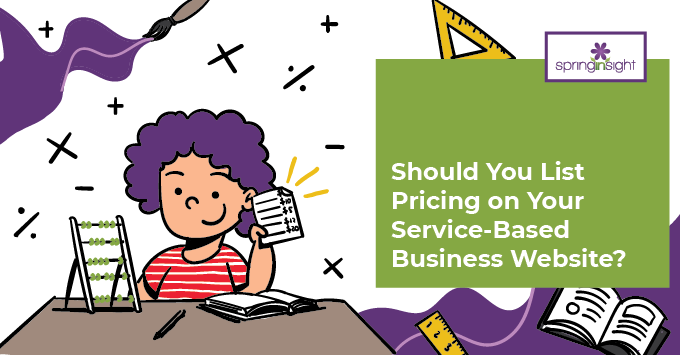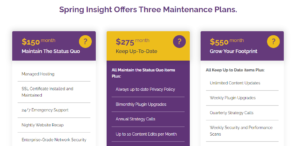
Should You List Pricing on Your Service-Based Business Website?
It’s September, and you know what that means! It’s back to school time! Alarms and hallway bells are ringing, either way too early in the morning or not nearly early enough in the afternoon. So, before your tan lines have even had the decency to fade away, it’s time to get back with the program and hit the ground running.
This month, Spring Insight is taking YOU back to school, too. We are releasing a series of articles planned around the educational foundation of the 3 R’s: Reading, Writing, and (A)Rithmetic. (You can get all caught up in class by checking out Reading and Writing.) Next week, we will wrap things up with the topic of grades because we are all dying to see just how well we did.
As a digital marketing agency, one of our services is website development. The question, “What does it cost to build a website?” is one we hear…like a lot. Another question we get a great deal is whether or not our clients should show pricing for their services on their business website.
In either case, the answer (naturally) is, “it depends.”
There are a wide variety of opinions on the subject and quite a few variables to consider. In this third installment of our Back to School series, we are going to do better than “it depends,” narrowing our numeric focus on the question of pricing. We will cover:
- Considerations to make when choosing to show pricing (or not)
- When and how publicly-listed pricing can be used to help both the business owner and the potential customer
- How to provide clearer estimates for attribute-based pricing with custom calculators
To Show (or Not Show) Your Pricing Online: That is the Question
The first consideration to make when choosing to list or omit pricing on your website is the type of service your business provides. In some instances, such as a software provider that has several tiered levels of product to deliver, pricing is static based on the package the buyer chooses. A business like that can confidently list its package pricing publicly on its website. And there are some benefits to both the company and the client, which we will get into a bit later.
However, regarding service-based businesses, static pricing is the exception, not the rule. Many service-based businesses build their pricing based on a number of attributes that change from client to client. They can’t really list a set of accurate numbers because their pricing is going to be specific to each client’s needs.
If your business is building new homes, you can’t really say how much it will cost to build. There are tons of factors to consider: the price of the land, the size of the home, the finishes chosen, and whether or not you go with the gold-plated toilet or standard porcelain. The options, as they say, are endless.
Service businesses that are in this attribute-based pricing model do have another option, though. They can list a “starting at” price for their various services.
- Tax prep starting at $X
- Tree trimming starting at $Y
- Tour itineraries starting at $Z
This is what we do on our own business website. There is a distinct advantage to both the client and the business this way, which just so happens to be the next subtopic.
Pricing on Your Website: An Advantage for Your Business and Your Potential Client
If your business is conducive to listing actual pricing or “starting at” pricing, there is a distinct advantage for both the business and your potential clients. Let’s look at both sides.
On the one hand, if you list your prices on your website, you run the risk of turning off a client conversation before it even begins. Let’s say a potential customer visits your website and decides they cannot afford your services. Or, on the flip side, they see your prices and decide you are not fancy enough for them. You have lost that potential customer without having the opportunity to negotiate or even explain your value proposition. Not great, right?
But, on the other hand, it could be that listing your pricing acts as a filter of sorts for potential clients that are a good fit for your business and those that are not. For example, at Spring Insight, our website design service starts at $8,500. If a business owner is looking for a web developer with a budget of $2,000, we can save each other a great deal of time and effort by having our “starting at” price listed. A client with a $2,000 budget is not our ideal client, and we are not a good fit for them, either.
In this way, listing your actual prices or “starting at” prices is beneficial to both your business and your potential clients. It answers the question “how much will it cost” for the potential client and saves the business owner a ton of time responding to those types of inquiries.
Integrating a Custom Calculator into your Business Website
There is an option that we are starting to see more of online and with our own clients, too. A web developer can build a custom calculator for your website. A potential client will enter their specific project parameters or the attributes that are relevant to their needs. In return, they receive a rough estimate of what their project or service will cost.
Think of the mortgage calculators you see on virtually every lender’s website. The potential client fills in their specifics, like the down payment and list price of the property, and they will receive a rough estimate of what a mortgage would cost them on a monthly basis. It’s like that but made especially for your services.
Of course, careful planning and consideration must be hardwired into the calculator. For instance, we worked with a client on creating a calculator for her service-based financial business’s website. We spent significant amounts of time and thought making sure that we were considering all relevant attributes. As a result, the calculator produced more accurate estimates.
The advantage of this approach is that it gives your potential client a view into the attributes that influence price and how complex the work you do really is. Of course, the potential client using the calculator should know that they cannot count on that estimate being the final firm price, but we also know that some people will attempt to take that estimate right to the mat in a pricing conversation.
We suggest making it crystal clear that the calculator is a rough estimate only and will not be honored as the final price. Words to that effect should be plainly visible on the website. That being said, business owners need to use it ethically as well. This tool should never be used to lure a potential client in with a super low offer that is significantly increased when all the details are ironed out.
And just like that, class is dismissed. Not too shabby for a math lesson, huh? We love a little arithmetic and would be happy to help your business build a custom calculator to help answer the question, “how much will it cost?” Book a consultation with us today. Mention the word CALCULATE, and we will sharpen our pencils on the pricing, too.

